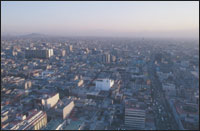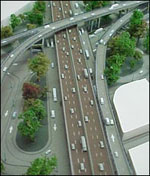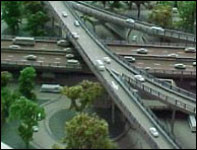Mexico City Mayor Andres Manuel Lopez Obrador has come a long way in the last decade — too far, some environmentalists would argue.

O, brador.
Photo: Gobierno del
Distrito Federal.
In February 1996, AMLO (as the Mexican press calls him) was arguably the country’s most prominent environmentalist, organizing a string of high-profile protests in his native Tabasco, in southeastern Mexico. The protests were aimed at forcing Pemex, the country’s state-owned oil monopoly, to clean up its act and prevent crude oil spills from wells in Tabasco’s lush, tropical plains and offshore in the Gulf of Mexico, where most of the company’s extraction takes place. Local fishers and farmers were fed up with having their livelihoods ruined by the oil spills, and AMLO cleverly harnessed their anger to rocket himself into the national spotlight.
In July 2000, as Vicente Fox was winning the Mexican presidency and ousting the long-ruling Institutional Revolutionary Party from power, AMLO made history of his own. The son of provincial shopkeepers and a populist from the left-of-center Democratic Revolution Party, Lopez Obrador was elected mayor of the world’s largest and possibly filthiest metropolis: Mexico City.

Mexico City smogline.
As AMLO well knew before taking office, Mexico City is home to countless environmental problems. Hundreds of thousands of squatters live on ecologically fragile land on the outskirts of the city, potentially contaminating the region’s watershed. Dangerous levels of ozone, hydrocarbons, and industrial pollutants sully the atmosphere — as do an estimated 600 tons of fecal dust that enter the capital’s air every day because as many as 3 million of the city’s inhabitants have no sewage system. Perhaps the greatest threat of all is the very real possibility that the aquifer below the conurbation might finally dry up, some 500 years after the conquering Spaniards first began draining the waters that once covered most of what today is the sprawling, chaotic capital city.
My Way Is the Highway
Any optimism felt by Mexico’s long-suffering environmental community after AMLO’s election quickly turned to dismay. The new mayor’s response to his city’s plague of environmental crises was profoundly disappointing. After a little over a year in power, he unveiled his flagship “environmental” project — a plan to build some 20 miles worth of extra road in the form of a second tier of three-lane highways on top of two of Mexico City’s busiest thoroughfares.

A model of the proposed project.
Photo: Gobierno del Distrito
Federal.
According to AMLO and his environment secretary, Claudia Sheinbaum, the project would dramatically reduce vehicle emissions by speeding up traffic. On the first road, the Viaducto, average speeds would rise from 9 miles per hour to 37 mph; on the second, the Periferico, speeds would jump from 19 mph to 37 mph. In the process, some $50 million worth of gas and productivity hours would be saved annually, AMLO and Sheinbaum claimed.
Environmentalists were appalled. They countered that far from reducing emissions, the project would only encourage more cars to take to Mexico City’s crowded, pot-holed streets, thereby worsening gridlock, lengthening commutes that in some cases already run into three and four hours, and further contributing to the notoriously abominable air quality. “They [AMLO and his administration] are not favoring sustainable transportation,” said Raul Benet, director of Greenpeace Mexico. “There is no long-term vision.”
Indeed, the genuine gains made in the city’s air quality over the last decade could even be sacrificed if the project goes ahead, some warned. They also predicted massive traffic jams at the entrances and exits to the second tiers, where all-but-stationary cars and trucks would belch more fumes into the filthy air. Environmentalists expressed concern about the possibility that city buses would only be allowed on the original roads below the second tiers, a move that would seem to encourage private vehicle use at the expense of public transportation.
Since the initial announcement of the project in December 2001, even federal Environment Secretary Victor Lichtinger has waded in to complain about it. “The idea is to invest heavily in public transport,” he said. “Suddenly, up pops this idea which runs counter to what we think should be the policy to reduce air pollution.”
Meanwhile, a group of prominent environmentalists took out full-page advertisements in national newspapers stating that, by launching the project, AMLO has broken the law in multiple ways — not least by failing to provide an adequate environmental impact report. The ads included a picture of remains of an Oakland double-decker freeway devastated by the 1989 Loma Prieta earthquake. With Mexico City sitting squarely in the middle of an area of heavy seismic activity, and with the public cynical about the integrity of local construction companies, the message was clear.

Two roads converged in the yellow
smog.
Photo: Gobierno del Distrito Federal.
Nevertheless, the project is moving forward. Already, a $160 million overpass is being built at the junction of the Viaducto and Periferico in the heart of the city. The rest of the project, which will cost upwards of $500 million, awaits budgetary approval from the Mexico City legislature and is slated to go ahead this year.
Sheinbaum declined to be interviewed for this story, but her chief advisor, Javier Riojas Rodriguez, admitted that it might have been a political error to associate the city’s Environmental Secretariat so closely with the project. When asked if the money could be better invested in the subway system or bike lanes for Mexico City’s bicyclists — one of the most put-upon cycling communities anywhere in the world — Riojas responded, “The subway system is not a priority, but that doesn’t mean that public transport is not a priority.” Environmentalists dispute that claim, saying the Environmental Secretariat and AMLO have shown no interest in promoting public transportation.
What AMLO is interested in is the presidency, said Alejandro Ramos, co-editor of the metropolitan section of Reforma, one of Mexico’s leading newspapers. Like many, Ramos believes that the mayor is readying himself for a presidential bid in 2006, and that the highway project is simply a way of spreading his electoral appeal to the middle classes. “He is basically interested in looking after the poor but needs to strengthen his popular base,” said Ramos. “The environment cannot compete with that.”
The question now is, if AMLO is elected president of Mexico in four years’ time, will the nation be as disappointed by his environmental policies as the people of Mexico City are today?

